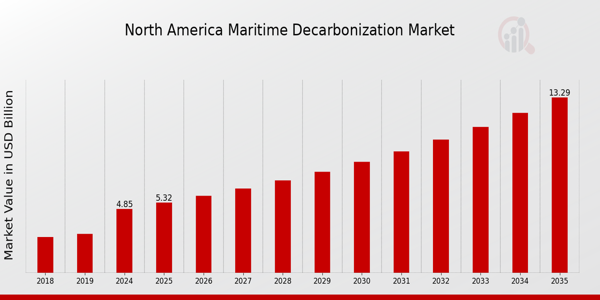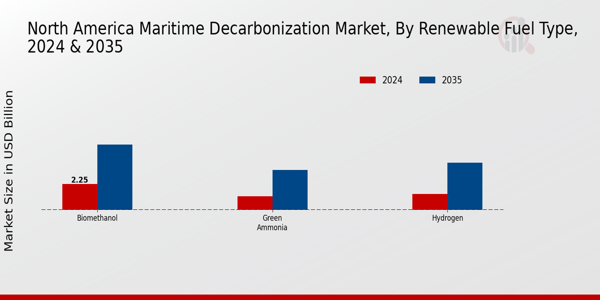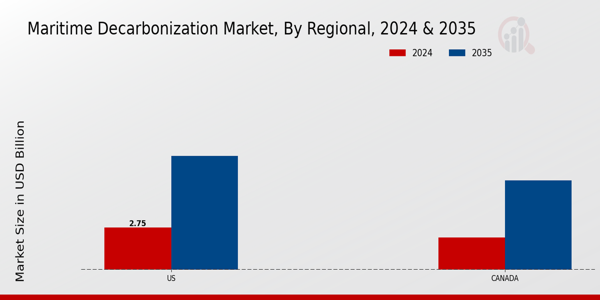
North America Maritime Decarbonization Market
North America Maritime Decarbonization Market Research Report: By Renewable Fuel Type (Green Ammonia, Hydrogen, Biomethanol), By Application (Ships, Ports, Others), andBy Regional (US, Canada)- Forecast to 2035
North America Maritime Decarbonization Market Overview:
As per MRFR analysis, the North America Maritime Decarbonization Market Size was estimated at 4.42 (USD Billion) in 2023.The North America Maritime Decarbonization Market is expected to grow from 4.85(USD Billion) in 2024 to 13.29 (USD Billion) by 2035. The North America Maritime Decarbonization Market CAGR (growth rate) is expected to be around 9.597% during the forecast period (2025 - 2035).
Key North America Maritime Decarbonization Market Trends Highlighted
As government agencies and industry participants place a greater emphasis on sustainability and emissions reduction, the North American Maritime Decarbonization Market is undergoing substantial changes.
Strict regulatory frameworks and programs aiming at reaching carbon neutrality by predetermined deadlines, like the United States' pledge to drastically cut greenhouse gas emissions by a particular target year, are important market drivers.
Investment in the study and development of substitutes such as hydrogen and ammonia fuels is being stimulated by the growing need for greener technology and greener fuels in maritime operations. As businesses search for creative ways to improve energy efficiency and lower their carbon footprint, opportunities abound.
Collaboration between IT companies and maritime operators holds great promise for deploying cutting-edge marine technologies and innovative energy management systems. Another option is the creation of regional green fuel supply chains, which can boost local economies and lessen reliance on imported conventional fuels.
In North America's varied marine industries, such as passenger and freight transportation, recent patterns show a move toward the broad use of electric ships and hybrid propulsion systems. The investigation of shore power systems to remove pollutants while ships are docked is also being prompted by initiatives from several governments, especially those along the coast.
Consumer desire for greener shipping choices is also being fueled by increased public awareness of climate change and its effects on the environment. All things considered, as stakeholders collaborate to create a sustainable future for the maritime sector, the North America Maritime Decarbonization Market is set to undergo a swift shift.

Source: Primary Research, Secondary Research, Market Research Future Database and Analyst Review
North America Maritime Decarbonization Market Drivers
Increasing Government Regulations and Policies
The North America Maritime Decarbonization Market is significantly influenced by stringent government regulations aimed at reducing greenhouse gas emissions from the maritime sector. The United States Environmental Protection Agency (EPA) has been actively working on implementing regulations to regulate emissions, including the Greenhouse Gas Emissions Standards for new marine vessels.
According to the EPA, the maritime sector is responsible for approximately 2.5% of total U.S. greenhouse gas emissions. With initiatives like the Green Vessel Initiative in California, which targets a 40% reduction in emissions from ships by 2030, there is a clear pathway and motivation for industry players to invest in decarbonization technologies.
These regulations not only promote environmental sustainability but also encourage innovation, driving significant investments in Research and Development (R&D) for alternative fuels and emission reduction technologies. Overall, the government’s commitment to environmental goals and stringent maritime regulations are expected to propel growth in the North America Maritime Decarbonization Market.
Growing Demand for Sustainable Shipping Solutions
The shipping industry is facing mounting pressure from consumers and businesses to adopt sustainable practices. With a significant portion of North American consumers now prioritizing eco-friendly delivery methods, companies are increasingly seeking to comply with this demand.
An International Maritime Organization (IMO) report indicated that a substantial increase in eco-conscious consumer behavior suggests that over 70% of consumers are willing to pay more for sustainable shipping options.
Major shipping companies in North America, such as Maersk and Hapag-Lloyd, are leading the market by investing heavily in environmentally friendly technologies, such as biofuels and battery-powered vessels. As consumer expectations continue to evolve, this demand for sustainable shipping solutions is a crucial driver for the North America Maritime Decarbonization Market.
Technological Advancements and Innovation
In the North America Maritime Decarbonization Market, technological progress plays a vital role in achieving sustainable maritime operations. Significant advancements in alternative fuel technologies, such as liquefied natural gas (LNG) and hydrogen fuel cells, are gaining traction among vessel operators.
The Department of Energy has reported that the United States is investing over 200 million USD in fuel cell technology research, with expectations of doubling the efficiency of ships by 2030.
Additionally, companies such as SeaChange Maritime Technologies are innovating with hybrid-electric propulsion systems that drastically reduce emissions. The ongoing advancements and investments in green technologies are essential to fostering competitiveness and sustainability in the market.
Corporate Sustainability Commitments
With increasing shareholder and stakeholder expectations for environmental responsibility, numerous shipping companies in North America are establishing corporate sustainability commitments. According to a recent survey by the Business Roundtable, over 90% of CEOs indicate that their companies are taking action to address climate change and are prioritizing sustainability in their operations.
Leading firms like Royal Caribbean Group and Carnival Corporation have pledged to achieve net-zero emissions by 2050. This growing commitment to sustainability not only enhances the corporate image and meets stakeholder demands but also advances the development of decarbonization initiatives.
The focus on corporate responsibility acts as a significant catalyst for the North America Maritime Decarbonization Market, driving research into cleaner technologies and operational practices.
North America Maritime Decarbonization Market Segment Insights:
Maritime Decarbonization Market Renewable Fuel Type Insights
The Renewable Fuel Type segment within the North America Maritime Decarbonization Market is pivotal as it addresses the pressing need for sustainable energy solutions in maritime operations. The shift towards renewable fuels, including Green Ammonia, Hydrogen, and Biomethanol, is being driven by regulatory frameworks and environmental commitments aimed at reducing greenhouse gas emissions.
Green Ammonia is gaining traction because of its potential to be produced from renewable energy sources and its ability to function as a zero-emission fuel in shipping. Its use not only mitigates carbon emissions but also aligns with the North American push for sustainable shipping practices, as it can replace traditional fossil fuels in freight.
Hydrogen stands out due to its versatility and ability to provide high energy content with zero emissions when utilized in fuel cells. In recent years, North America has ramped up efforts to develop hydrogen infrastructure, which remains a crucial factor in promoting its adoption within the maritime industry.
Consequently, the investment in hydrogen fuel technologies is anticipated to escalate, facilitating cleaner maritime operations and contributing to broader decarbonization goals. Biomethanol, produced from biomass feedstocks, also plays a significant role in the renewable fuel landscape. Its liquid form is advantageous for shipping applications, making it a feasible alternative fuel.
The rising emphasis on circular economy principles within North America is expected to bolster the demand for Biomethanol, as it offers a sustainable pathway to fuel production while utilizing waste materials.
As the North America Maritime Decarbonization Market evolves, the transition toward these renewable fuel types is expected to be fueled by enhancing technologies, significant governmental and private sector investments, and increasing awareness of environmental stewardship among key stakeholders.
Each of these renewable fuels strategically addresses the challenges of emissions regulation while offering diverse solutions that can enhance sustainability in maritime operations. The integration of such alternative fuels is crucial for meeting future emissions targets and fostering a sustainable maritime sector in North America.

Source: Primary Research, Secondary Research, Market Research Future Database and Analyst Review
Maritime Decarbonization Market Application Insights
The North America Maritime Decarbonization Market is witnessing a significant transformation driven by diverse applications, prominently focusing on Ships and Ports, while also encompassing other areas. The push for sustainability in the shipping industry has correlated strongly with stringent environmental regulations.
Ships are evolving with advanced technologies aimed at reducing emissions, contributing to the ongoing effort toward decarbonization. Ports play a pivotal role as they adopt innovative solutions to improve efficiency and reduce carbon footprints, ultimately supporting greener supply chains and logistics.
The involvement of major ports in transitioning toward eco-friendly practices reflects a growing recognition of their impact on local environments. In addition, the 'Others' category includes various ancillary services and technologies crucial for supporting the maritime ecosystem, promoting efficiency and lower emissions across the sector.
The North America Maritime Decarbonization Market revenue is expected to benefit from these collaborative efforts, indicating a shift toward sustainable practices that are likely to dominate the market landscape in the upcoming years.
With evolving regulatory frameworks and technological innovations shaping this market, opportunities for growth and investment in decarbonization strategies are abundant, making this sector increasingly significant in the region.
Maritime Decarbonization Market Regional Insights
The North America Maritime Decarbonization Market reflects significant progress in reducing carbon emissions within the maritime sector, emphasizing regulations and sustainable practices across the region.
The market segmentation highlights the dominant players such as the United States and Canada, where efforts to enhance green shipping technologies and alternative fuels are gaining traction. The United States, with its robust maritime fleet and extensive port infrastructure, plays a crucial role in driving innovation and investments in decarbonization technologies.
Meanwhile, Canada supports this movement through stringent environmental policies that encourage the adoption of green technologies among shipping companies. Both countries are prioritizing Research and Development initiatives that focus on efficient energy use and renewable energy sources, helping to mitigate the impact of the maritime industry on climate change.
The potential for collaboration between public and private sectors further fosters advancements in this market. Overall, the focus on decarbonization is aligned with broader North American goals of achieving sustainability and addressing climate change challenges.

Source: Primary Research, Secondary Research, Market Research Future Database and Analyst Review
North America Maritime Decarbonization Market Key Players and Competitive Insights:
The North America Maritime Decarbonization Market reflects a crucial shift towards sustainable shipping practices amid growing environmental concerns and regulatory pressures. Various stakeholders, including shipping companies, regulators, and technology providers, are collaborating to reduce greenhouse gas emissions and improve energy efficiency in this sector.
As marine transportation is integral to the North American economy, the commitment to decarbonization plays a significant role in shaping the competitive landscape. Organizations are increasingly investing in innovative technologies, alternative fuels, and cleaner operational practices to align with international standards and meet consumer expectations for sustainable development.
The market is characterized by a vibrant mix of established industry players and emerging startups focusing on pioneering solutions and breaking into an evolving marketplace.
Within the North America Maritime Decarbonization Market, Shell has positioned itself as a formidable player by emphasizing its commitment to sustainable energy principles and its strategic investments in low-carbon technologies.
Shell's strengths lie in its extensive expertise in energy, established global supply chains, and comprehensive research and development capabilities which allow for innovation in fuel alternatives like liquefied natural gas (LNG) and biofuels tailored for marine applications.
The company has actively participated in collaborative efforts with industry partners to develop infrastructure supporting the energy transition while ensuring compliance with environmental regulations.
By leveraging its strong brand and infrastructure, Shell seeks to provide reliable and efficient energy solutions that cater specifically to the decarbonization needs of the maritime sector in North America, thereby enhancing its competitive edge.
Carnival Corporation, a significant player in the North America Maritime Decarbonization Market, has demonstrated a proactive approach to integrating sustainable practices across its operations. The company is focused on reducing its carbon footprint and enhancing energy efficiency through investments in advanced ship design and technology, as well as a commitment to alternative fuels.
Carnival Corporation boasts a strong market presence due to its extensive fleet and established reputation in the cruise industry. Notably, the company has undertaken various initiatives, including partnerships aimed at research and technological advancements, to improve energy efficiency and explore renewable energy sources.
Having engaged in strategic mergers and acquisitions over the years, Carnival Corporation has bolstered its capability to deploy sustainable innovations. This positions it well within the North American market, as the company aligns its growth trajectory with the broader objectives of decarbonization in the maritime industry.
Key Companies in the North America Maritime Decarbonization Market Include:
Shell
Carnival Corporation
Nautilus Data Technologies
UPS
Norwegian Cruise Line Holdings
General Electric
Royal Caribbean Group
ABB
Equinor
Wärtsilä
DHL
HapagLloyd
FedEx
BHP
Maersk
North America Maritime Decarbonization Market Developments
Recent developments in the North America Maritime Decarbonization Market have seen significant investment and strategic partnerships aimed at reducing carbon emissions. Shell has been actively exploring sustainable fuel alternatives, while Carnival Corporation announced its commitment to net-zero emissions by 2050, enhancing its fleet with low-carbon technologies.
Nautilus Data Technologies is pioneering data solutions to improve energy efficiency in maritime operations. Meanwhile, UPS and FedEx are expanding their logistics capabilities to adopt greener shipping methods. Norwegian Cruise Line Holdings and Royal Caribbean Group have introduced initiatives to utilize liquefied natural gas and other renewable energy sources in their fleets.
Notable mergers include Wärtsilä's acquisition of certain assets from a technology company to advance decarbonization efforts in July 2022, reflecting the sector's consolidation toward sustainable practices. In recent years, Hapag-Lloyd has increased its focus on carbon-neutral services as regulations tighten.
Changes in U.S. maritime policies and international agreements are influencing shipping companies like Maersk, enhancing their commitment to environmentally friendly operations. The government's push for infrastructure investments supporting clean fuel technologies further emphasizes the strategic transformation in the North America Maritime Decarbonization Market.
North America Maritime Decarbonization Market Segmentation Insights
Maritime Decarbonization Market Renewable Fuel Type Outlook
Green Ammonia
Hydrogen
Biomethanol
Maritime Decarbonization Market Application Outlook
Ships
Ports
Others
Maritime Decarbonization Market Regional Outlook
US
Canada
FAQs
What is the expected market size of the North America Maritime Decarbonization Market in 2024?
The North America Maritime Decarbonization Market is expected to be valued at 4.85 USD Billion in 2024.
How fast is the North America Maritime Decarbonization Market projected to grow until 2035?
The market is projected to achieve a compound annual growth rate (CAGR) of 9.597% from 2025 to 2035.
What will the expected market value be by 2035?
The North America Maritime Decarbonization Market is expected to reach approximately 13.29 USD Billion by 2035.
Which region has the largest market share within the North America Maritime Decarbonization Market?
The US holds the largest market share, expected to be valued at 2.75 USD Billion in 2024.
How does the Canadian market compare to the US market in 2024?
The Canadian segment of the North America Maritime Decarbonization Market is expected to be valued at 2.1 USD Billion in 2024.
What are the projected market values for Green Ammonia by 2035?
Green Ammonia is projected to be valued at 3.5 USD Billion in 2035.
What is the expected market value for Hydrogen in 2024?
The market value for Hydrogen in the North America Maritime Decarbonization Market is expected to be 1.4 USD Billion in 2024.
Who are the major players in the North America Maritime Decarbonization Market?
Key players in this market include Shell, Carnival Corporation, UPS, and General Electric among others.
What is the expected market size of Biomethanol in 2035?
Biomethanol is expected to be valued at approximately 5.69 USD Billion in 2035.
What growth opportunities exist for the North America Maritime Decarbonization Market?
Opportunities in the market stem from the shift towards sustainable fuels like Green Ammonia and Hydrogen.
Kindly complete the form below to receive a free sample of this Report
Customer Stories

“This is really good guys. Excellent work on a tight deadline. I will continue to use you going forward and recommend you to others. Nice job”

“Thanks. It’s been a pleasure working with you, please use me as reference with any other Intel employees.”

“Thanks for sending the report it gives us a good global view of the Betaïne market.”

“Thank you, this will be very helpful for OQS.”

“We found the report very insightful! we found your research firm very helpful. I'm sending this email to secure our future business.”

“I am very pleased with how market segments have been defined in a relevant way for my purposes (such as "Portable Freezers & refrigerators" and "last-mile"). In general the report is well structured. Thanks very much for your efforts.”

“I have been reading the first document or the study, ,the Global HVAC and FP market report 2021 till 2026. Must say, good info! I have not gone in depth at all parts, but got a good indication of the data inside!”

“We got the report in time, we really thank you for your support in this process. I also thank to all of your team as they did a great job.”

Leave a Comment